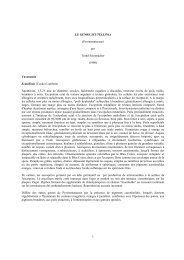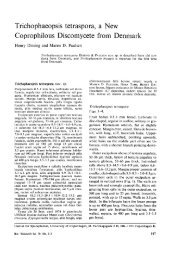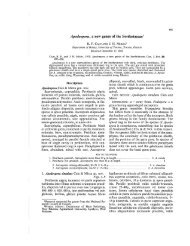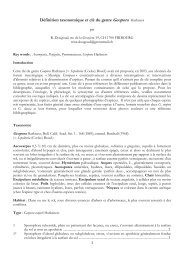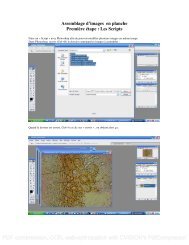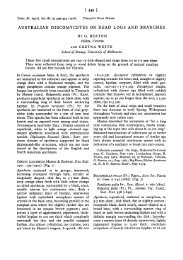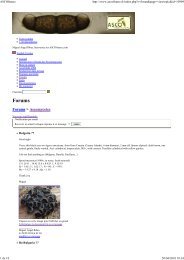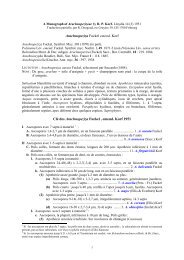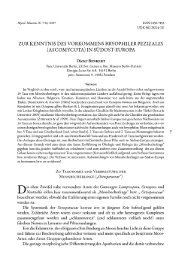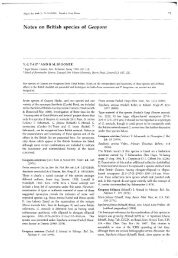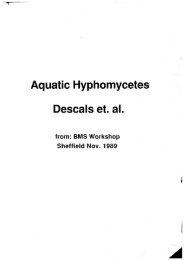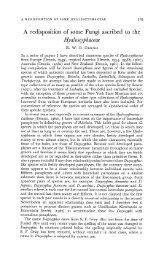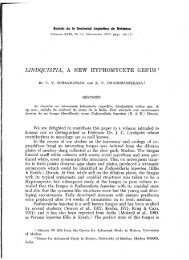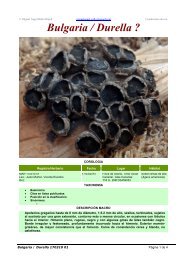Stray Studies in the Coronophorales (Pyrenomycetes) 4-8 - ASCOfrance
Stray Studies in the Coronophorales (Pyrenomycetes) 4-8 - ASCOfrance
Stray Studies in the Coronophorales (Pyrenomycetes) 4-8 - ASCOfrance
You also want an ePaper? Increase the reach of your titles
YUMPU automatically turns print PDFs into web optimized ePapers that Google loves.
306 J. A. Nannfeldtembrac<strong>in</strong>g no less than 16 generic names based on its well 20 species. (In <strong>the</strong>nomenclators for <strong>the</strong> <strong>in</strong>dividual species appear a total of 20 additional generic namesthat Nitschkiae have been described under or comb<strong>in</strong>ed with and as synonyms 20specific and <strong>in</strong>fraspecific epi<strong>the</strong>ts!)Somebody may consider it a mere waste of paper to publish <strong>the</strong>se nomenclators <strong>in</strong>such detail, but <strong>the</strong> bitter words on <strong>the</strong> polypores by my late friend M. A. Donk areof general applicability: "Dur<strong>in</strong>g <strong>the</strong>se activities I encountered a compla<strong>in</strong>t dat<strong>in</strong>gfrom as long as 150 years ago that revealed that a fail<strong>in</strong>g common to many a modernauthor is of long stand<strong>in</strong>g: 'The practice of accurately exam<strong>in</strong><strong>in</strong>g <strong>the</strong> synonyms,<strong>in</strong>stead of copy<strong>in</strong>g <strong>the</strong>m from o<strong>the</strong>r authors, has been too long neglected' (Purton,App. Midi. Fl. 335. 1821). The fail<strong>in</strong>g has culm<strong>in</strong>ated <strong>in</strong> a number of errors andpuzzles <strong>in</strong> references <strong>in</strong> some of <strong>the</strong> much used European publications that is reallystupendous" (Donk 1974: 5-6).Nitschkia Otth <strong>in</strong> Fuck., Symb. mycol. p. 165 (1870; nom. nud.); ex Karst., Mycol.fenn. 2: 13 (1873). — Lectotypus: N.fuckelii Nke=A f . cupularis sensu Karst., i.e. N.parasitans.[Cyathisphaera Dum., Comment, bot. p. 87 (1822) p.p. (vide Nannfeldt 1975:60-61).]Coelosphaeria Sacc., Atti Soc. Ven.-Trent. Sei. Nat. 2(2): 163 (xii.1873) — Nom. nov. proNitschkia, diatomearum generis Nitzschiae Hassall causa; nom. nud. et superfl. (cp. NannfeldtI.e.).Fracchiaea Sacc., ibid, (xii.1873). — Typus: Fr. heterogenea Sacc., i.e. N. broomeiana.Echusias Hazsl., Verh. zool.-bot. Ges. Wien 23:367 (xii.1873). — Typus: E. Vitis "(Schulzer)"Hazsl. [non Gibbera Vitis Schulzer], i.e. N. broomeiana. — Syn. fide Höhnel 1920:130-131.Scortech<strong>in</strong>ia Sacc. <strong>in</strong> Sacc. & Berl., Atti R. Ist. Venet. Sei. Lett. Art. 6(3:4): 713 (1885). —Typus: Sphaeria acanthostroma Mont.Tympanopsis Starb., Bih. K. Sv. Vet.-Akad. Handl. 19(3:2):24(1894). — Typus: Sphaeriaeuomphala Berk. & Curt., i.e. N. confertula.W<strong>in</strong>terella Berl., Icon, fung. 1(3):94 (1892) [non W<strong>in</strong>terella O. Kze (1891) nec W<strong>in</strong>terellaSacc. (1899)]. — Typus: W<strong>in</strong>teria tuberculífera ("tuberculigera") Ell. & Ev., i.e. N. grevillii.W<strong>in</strong>ter<strong>in</strong>a Sacc., emend. Sacc. & Syd. <strong>in</strong> Sacc., Syll. fung. 14:589 (1899) [non sensu orig.,Syll. fung. 9:909 (1891)]. — Lectotypus: W<strong>in</strong>teria tuberculífera Ell. & Ev., i.e. N. grevillii.Coronophorella Höhn., Sitz.ber. Akad. Wiss. Wien, Math.-nat. Kl. 118(1): 1507 (1909). —Typus: Enchnoa chaetomioides Penz. & Sacc.Teratonema H. & P. Syd., Ann. Mycol. 15(3^1): 180 (1917). — Typus: Asterulacorniculariiformis P. Henn., i.e. N. acanthostroma.? Schizocapnodium Fairm., Proc. Rochester Acad. Sei. 6(3): 93 (1921). — Typus: Sch.sarc<strong>in</strong>ellum Fairm. (comp, below p. 318).Calyculosphaeria Fitzp., Mycologia 15(2): 45 (1923). —Nov. nom. pro W<strong>in</strong>terella Berl.Biciliospora Petr., Sydowia 6(5-6):429 (1952). — Typus: B. velut<strong>in</strong>a Petr. — Syn. ex descr.Scortech<strong>in</strong>iella Arx & Müll., Beitr. Krypt.-fl. Schweiz 11(1): 382 (1954). — Typus: Trichosphaerellasimilis Bres.Scortech<strong>in</strong>iellopsis Sivanesan, Trans. Brit. Mycol. Soc. 62(1): 36 (1974). — Typus: Sc.leonensis Sivanesan.Svensk Bot. Tidskr. 69 (1975)



